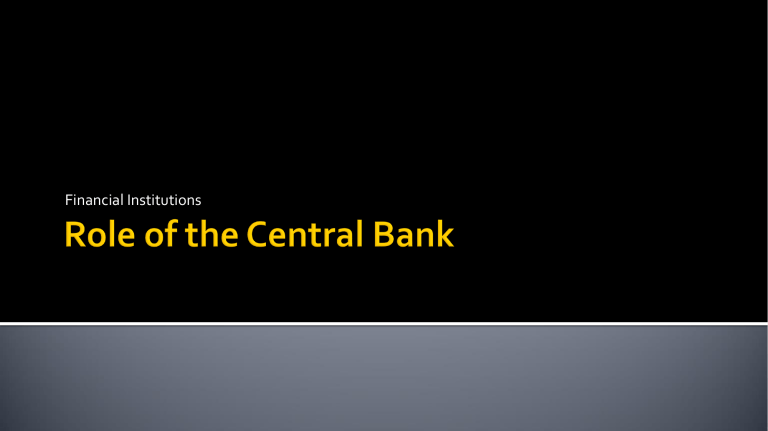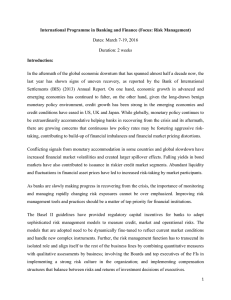
Financial Institutions Definition of Central Bank Role of the Central Bank of Jamaica Main Functions of the Central Bank The Central Bank is the head of the financial sector in any economy and is also regarded as the government’s bank. The Central Bank twofold purpose is: -To oversee the operations of all financial institutions -To implement monetary policy on behalf of the government 1. 2. 3. 4. 5. 6. 7. It has the sole rights to issue notes and coins It acts as the government’s bank It acts as the banker to commercial banks Manages the foreign exchange reserves Provides economic and financial advise to the government It is a lender of last resort Implements monetary policy on behalf of the government The central bank is the sole issuer of new notes and coins in the economy. It also accepts and replaces unfit notes and coins. - - As banker to the Government, the Bank: administers some of the Government's main deposit accounts services the Government's external public debts acts as agent for the Government. This involves the maintenance of accounts of the Central Government and the subsidiary accounts of some public sector agencies. All commercial banks must keep a percentage of their deposits as cash reserves at the central bank. The central bank lends to the commercial banks when necessary. Commercial banks also seek and accept advice from the central bank. They have to report regularly to the central bank on various aspects of their operations. As banker to commercial banks the BOJ exercises oversight responsibilities for a clearing system, which provides for the clearance and settlement of transactions between banks. The Central Bank looks after the foreign exchange reserves. It ensures that the country always has sufficient reserves and if it does not, it advises the government on the appropriate policy. The Governor of the Central Bank advises the Minister of Finance on macroeconomic and financial matters. In fulfilling this function, the Bank maintains an extensive economic database and conducts research on areas relevant to economic policy. The central bank lends to sectors of the financial system when they are unable to borrow from elsewhere. This is particular important during a recession Monetary policy refers to the actions taken by a Central Bank with the Ministry of Finance to create and manage the quantity of money in the economy and interest rate. To implement monetary policy various monetary tools/ instruments are use. Monetary policy tools are designed to influence the level of liquidity in the financial system. Monetary Policy Tools include: Reserve Requirement Open Market Operations Moral Suasion Interest Rate Discount Rate The Central Bank acts as an umbrella bank for all the banks in the country, therefore all the banks are obliged by law to have accounts with the Central Bank. Such accounts are called cash reserve requirement (CRR) accounts. The banks are required to keep a certain percentage of their deposit at the Central Bank. It facilitates transactions between the Central Bank and commercial banks, and further ensures liquidity and safety of banks. The CRR therefore acts as a monetary policy instrument, i.e. increasing/decreasing the CRR affects banking liquidity and credit extension. Open Market Operations (OMO) forms part of the arsenal of tools that the Bank uses to manage liquidity in the economy. Through OMO, the Bank buys and sells debt securities in the market to influence the liquidity conditions. The Open Market Operations refers to the sale and purchase of government securities and treasury bills by the central bank of the country with a view to regulate the supply of money in the economy. Simply, the process in which the central bank requests or persuade the commercial banks to comply with the general monetary policy of the central bank is called a moral suasion. The discount rate is the interest rate at which commercial banks borrow money from the Central Bank, in turn, affects other interest rates in the economy. The interest rate is the percent of principal charged by the lender for the use of its money.



